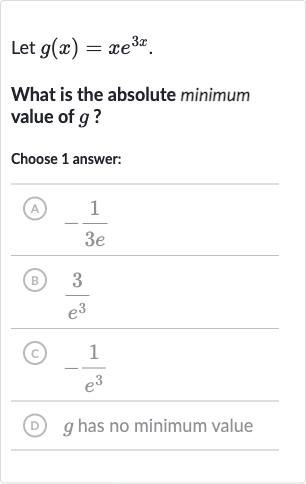Full solution
Q. Let .What is the absolute minimum value of ?Choose answer:(A) (B) (C) (D) has no minimum value
- Find Derivative: To find the absolute minimum value of the function , we need to find the critical points by taking the derivative of and setting it equal to zero.Let's find the derivative .Using the product rule, where , let and .Now apply the product rule.
- Set Equal to Zero: Now we set the derivative equal to zero to find the critical points.Factor out from both terms.Since is never zero, we can divide both sides by to get:Now solve for x.x =
- Critical Point Analysis: We have found a critical point at . To determine if this is a minimum, we can use the second derivative test or analyze the behavior of the first derivative around the critical point. Let's use the second derivative test.Find the second derivative .Using the product rule again for the second term, where and , we get:Now apply the product rule.
- Second Derivative Test: Now we evaluate the second derivative at the critical point .Since is positive, the second derivative is positive at , which means the function is concave up at this point, and thus is a local minimum. Because the function goes to negative infinity as goes to negative infinity and to positive infinity as goes to positive infinity, this local minimum is also the absolute minimum.
- Evaluate Second Derivative: Now we need to find the value of at the critical point to determine the absolute minimum value. This corresponds to answer choice (A).
More problems from Multiplication with rational exponents
QuestionGet tutor help
QuestionGet tutor help
QuestionGet tutor help
QuestionGet tutor help
QuestionGet tutor help
QuestionGet tutor help
QuestionGet tutor help
QuestionGet tutor help
QuestionGet tutor help



